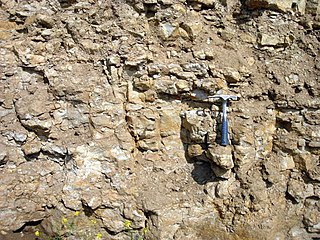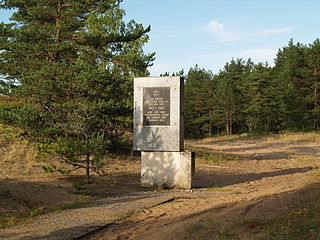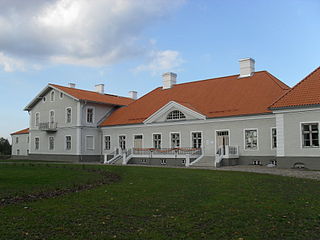
Majdanek was a Nazi concentration and extermination camp built and operated by the SS on the outskirts of the city of Lublin during the German occupation of Poland in World War II. It had seven gas chambers, two wooden gallows, and some 227 structures in all, placing it among the largest of Nazi concentration camps. Although initially intended for forced labor rather than extermination, it was used to murder people on an industrial scale during Operation Reinhard, the German plan to murder all Polish Jews within their own occupied homeland. In operation from 1 October 1941 to 22 July 1944, it was captured nearly intact. The rapid advance of the Soviet Red Army during Operation Bagration prevented the SS from destroying most of its infrastructure, and Deputy Camp Commandant Anton Thernes failed to remove the most incriminating evidence of war crimes.

Kohtla-Järve is a city and municipality in northeastern Estonia, founded in 1924 and incorporated as a town in 1946. The city is highly industrial, and is both a processor of oil shales and is a large producer of various petrochemical products. During the 1944–1991 Soviet occupation, large numbers of immigrant workers from Russia and other parts of the former USSR were brought in to populate the rapidly growing city. The population in the Kohtla-Järve area which had been, as of 1934 census, over 90% ethnic Estonian, became overwhelmingly non-Estonian in the second half of the 20th century. According to more recent data 21% of the city's population are ethnic Estonians; most of the rest are Russians. Kohtla-Järve is the fifth-largest city in Estonia in terms of population.

Klooga concentration camp was a Nazi forced labor subcamp of the Vaivara concentration camp complex established in September 1943 in Harju County, during World War II, in German-occupied Estonia near the village of Klooga. The Vaivara camp complex was commanded by German officers Hans Aumeier, Otto Brennais and Franz von Bodmann and consisted of 20 field camps, some of which existed only for short periods.
Klooga is a small borough in Lääne-Harju Parish in Harju County in northern Estonia. At the 2011 Census, the settlement's population was 1,203, of which the Estonians were 642 (53.4%).

In the course of Operation Barbarossa, Nazi Germany invaded Estonia in July–December 1941, and occupied the country until 1944. Estonia had gained independence in 1918 from the then-warring German and Russian Empires. However, in the wake of the August 1939 Nazi-Soviet Pact, the Soviet Union had invaded and occupied Estonia in June 1940, and the country was formally annexed into the USSR in August 1940.

The history of Jews in Estonia starts with reports of the presence of individual Jews in what is now Estonia from as early as the 14th century.
Enefit Kaevandused was a mining company located in Jõhvi, Estonia. It was a subsidiary of Eesti Energia, an Estonian state-owned energy company. The core activity of Enefit Kaevandused was oil-shale mining. The produced oil shale was mainly used for shale oil production and to fuel oil shale-fired power stations in the north–east of Estonia. As of 2009, the company had 3,150 employees. The last chief executive officer was Andres Vainola. The company produced more than 17 million tons of oil shale in 2013.
Viru Keemia Grupp (VKG) is an Estonian holding group of oil shale industry, power generation, and public utility companies.

The Holocaust in Estonia refers to Nazi crimes during the occupation of Estonia by Nazi Germany.

Vaivara Parish is a former municipality of Ida-Viru County in northern Estonia. It had a population of 1,800 (2008) and an area of 397.97 km². Vaivara Parish was abolished in 2017 and its territory became a part of Narva-Jõesuu.

Janowska concentration camp was a German Nazi concentration camp combining elements of labor, transit, and extermination camps. It was established in September 1941 on the outskirts of Lwów in what had become, after the German invasion, the General Government. The camp was named after the nearby street Janowska in Lwów of the interwar Second Polish Republic.

There are two kinds of oil shale in Estonia, both of which are sedimentary rocks laid down during the Ordovician geologic period. Graptolitic argillite is the larger oil shale resource, but, because its organic matter content is relatively low, it is not used industrially. The other is kukersite, which has been mined for more than a hundred years. Kukersite deposits in Estonia account for 1% of global oil shale deposits.

Mark Dvorzhetski was an Israeli physician, historian and Holocaust survivor.

Jägala concentration camp was a labour camp of the Estonian Security Police and SD during the German occupation of Estonia during World War II. The camp was established in August 1942 on a former artillery range of the Estonian Army near the village of Jägala, Estonia. It existed from August 1942 to August 1943. Aleksander Laak, an Estonian, was appointed by SS-Sturmbannführer Ain-Ervin Mere of Group B of the Estonian Security Police to command the camp with Ralf Gerrets as assistant.

Kukruse is a village in Toila Parish, Ida-Viru County in northeastern Estonia. It is located by the Tallinn–Narva road (E20), between the cities of Kohtla-Järve and Jõhvi. Adjacent to the village is a district of Kohtla-Järve sharing the same name, Kukruse.
Franz Hermann Johann Maria Freiherr von Bodmann, sometimes written as Bodman was a German SS-Obersturmführer who served as a camp physician in several Nazi concentration camps.
Inge Sylten was a young Jewish girl from Czechoslovakia who was deported in a transport from Theresienstadt Ghetto to Estonia in September 1942. Heinz Drosihn was an SS-Unterscharführer and the commandant of Ereda concentration camp in Estonia. Their paths intersect in the camp, where they fell in love, were forced to flee, and subsequently were shot or committed suicide during their flight to Scandinavia. Their story was preserved mainly thanks to fellow inmates of Inge Sylten. The Czech filmmaker and researcher Lukáš Přibyl called their story "... Romeo and Juliet story in a concentration camp".
Bruno Kittel was an Austrian Nazi functionary in the German SS and Holocaust perpetrator who oversaw the liquidation of the Vilna Ghetto in September 1943. Kittel became known for his cynical cruelty. He disappeared after the war.
Wolf Durmashkin was a Jewish composer, conductor and pianist in Vilnius, Lithuania. He was murdered in the Holocaust.

Kauen was a Nazi concentration camp located in the former Kovno Ghetto. It operated from 15 September 1943 to 14 July 1944 and had seventeen satellite camps located around the city of Kaunas, in modern-day Lithuania. Most prisoners were Jews who had survived the previous years of the Holocaust in Lithuania. In July 1944, eight of the subcamps were closed. The main camp was liberated by the Red Army on 1 August 1944.













